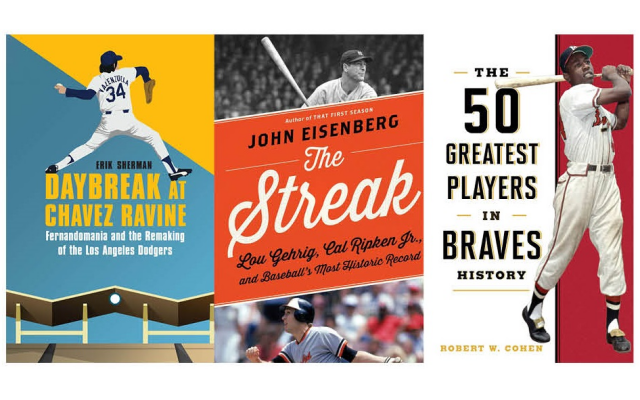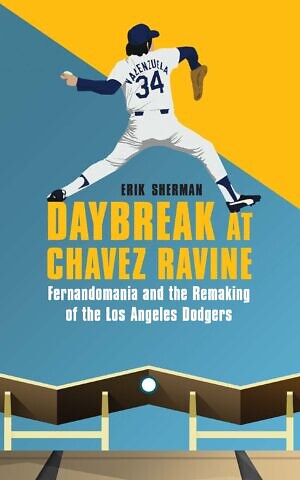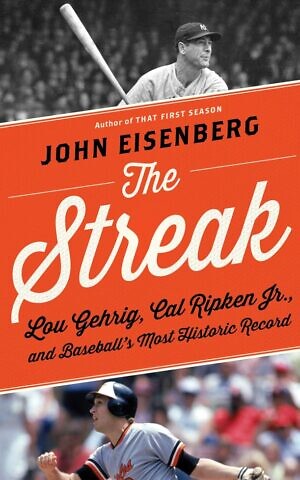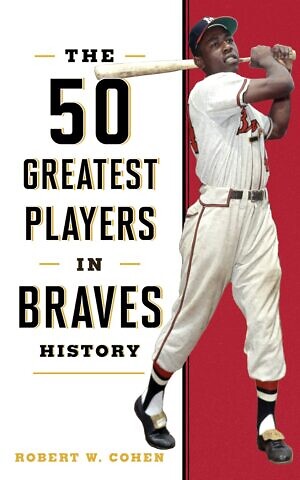Top Sports Books for Father’s Day
The AJT’s sportswriter curates a selection of books that would make ideal gifts for the dads who just can’t get enough sports.

Daybreak at Chavez Ravine: Fernandomania and the Remaking of the Los Angeles Dodgers – by Erik Sherman
Ostensibly a biography of trailblazing lefty pitcher, Fernando Valenzuela, “Daybreak at Chavez Ravine: Fernandomania and the Remaking of the Los Angeles Dodgers” brilliantly chronicles a sliver of Dodgers history that continues to reverberate in the modern day. Authored by baseball historian Erik Sherman, whose previous works include Art Shamsky’s autobiography (After the Miracle), “Daybreak at Chavez Ravine” doesn’t just depict the life and times of its cult hero subject – it also provides a poignant look into the complicated relationship the legacy franchise has had with the Greater Los Angeles Latino community, and how that dynamic made Valenzuela’s emerging stardom an even more compelling story.

Before delving into Valenzuela’s impoverished upbringing as the youngest of 12 children raised in the farming town of Etchohuaquila, in the Mexican state of Sonora, Sherman offers a vivid portrayal of the forced displacement of Mexican Americans residing in Chavez Ravine. At times, it’s difficult to read, but nevertheless enlightening. So, although “Daybreak at Chavez Ravine” is unmistakably a baseball book, it also holds lasting appeal to students of American history with its gripping account of the injustices faced by Latin-American, blue-collar workers trying to establish themselves in post-World War II America.
Ultimately, what makes “Daybreak at Chavez Ravine” such a compelling read is not only Sherman’s deft storytelling but also his dogged research, as evidenced by the insight provided by scores of first-hand interviews. Ironically, and as Sherman explains, understandably, not one involved Valenzuela himself. For all the adoration Valenzuela has received from Dodger nation – during his heyday, his image was plastered on murals, advertisements, and T-shirts across Los Angeles, and to this day his replica jersey is a common sight at Dodger Stadium – the six-time All-Star continues to eschew the spotlight and, as such, was not particularly interested in cooperating for this book. But while Valenzuela’s own perspective may be missing, “Daybreak at Chavez Ravine” still represents a rich and comprehensive account of Valenzuela’s remarkable life thanks to the revealing commentary from the likes of Steve Garvey, Dusty Baker, Rick Monday, Jerry Reuss, and so many other household baseball names.
Though younger readers may struggle to relate to Valenzuela, who broke into the big leagues in the early 1980s, as well as his aforementioned contemporaries, the list of interviewees include ballplayers from the more recent era, such as six-time All-Star Nomar Garciaparra, who shares some very personal stories about his Mexican American heritage. For good measure, the Valenzuela-heavy narrative, at times, branches off into other instrumental figures of early 1980s baseball, including famed Dodgers manager Tommy Lasorda and Marvin Miller, the former executive director of the Major League Baseball Players Association who posthumously represents the Jewish community in Cooperstown.
Inevitably, there will be readers wondering why Valenzuela serves as the subject of this long-awaited biography or the similarly fantastic 2010 ESPN Films 30 for 30 documentary entitled, “Fernando Nation.” After all, the screwball artist with the everyman body had a severely front-loaded career marked by a 173-153 record and 3.54 ERA — solid numbers, for sure, but hardly ones representing Hall of Fame credentials. But, as Sherman makes abundantly clear in the book’s preface, Valenzuela’s long-lasting impact on baseball history transcends box scores and stat lines.
“He was like a composite of the Beatles – only in Dodger blue,” writes Sherman. “His appeal was universal. He wasn’t just a baseball player, he was a healer in a time when, much like today, many Americans viewed Mexicans as second-class citizens. He was to Latinos what Jackie Robinson was to Black Americans. And their feelings for Valenzuela have only grown stronger over the years.”
The Streak: Lou Gehrig, Cal Ripken Jr., and Baseball’s Most Historic Record – by John Eisenberg
“The Streak: Lou Gehrig, Cal Ripken Jr., and Baseball’s Most Historic Record,” written by noted sports author and former Baltimore Sun columnist John Eisenberg, was published in 2017, but the book’s unique narrative, which interweaves the iconic careers of two Hall of Famers from vastly different eras, remains evergreen in the storied canon of baseball literature.

To illustrate the magnitude of Baltimore Orioles shortstop Cal Ripken Jr. breaking Lou Gehrig’s decades-old consecutive played games record (2,130), Eisenberg begins by revisiting the magical evening of Sept. 6, 1995, when history unfolded at Baltimore’s splendid new ballpark known as Oriole Park at Camden Yards.
Whether readers were not alive to witness this momentous occasion that truly transcended sports (once the Orioles-Angels game became official in the bottom of the fifth inning, play was paused for nearly a half hour as Ripken memorably circled the field to acknowledge the adoring fans in attendance, one of whom was then-President Bill Clinton) or simply forget how it restored some dignity to a sport recently besmirched by labor strife, the anecdote serves as a perfect segue into the ensuing look-back at baseball’s two iconic iron men.
While Eisenberg, who spent years covering the Orioles for the Baltimore Sun, takes a deep dive into Ripken, his royal baseball family, and the lineage’s deep Baltimore roots, he also devotes several chapters toward exploring the brilliant, heroic, and ultimately tragic legacy of Lou Gehrig, who succumbed to a disease (ALS) that eventually bore his name. (In fact, largely due to Gehrig’s story, Major League Baseball has become particularly invested in ALS and now recognizes June 2 as Lou Gehrig Day.) In doing so, Eisenberg provides fitting historical context to Ripken’s pursuit of baseball immortality – after all, Ripken was a .276 career hitter who was chasing the seemingly untouchable record set by a man in Gehrig, who, during the New York Yankees’ early 20th century dynastic years, was the gold standard for durability, hitting prowess, and gracefulness, and whose life story was depicted in the classic film, “The Pride of the Yankees.”
Of further value to readers, Eisenberg, despite being a longtime Baltimore resident, maintains an impartial approach toward narrating his story, making it quite clear that Ripken’s insistence on playing every single game – even while being hampered with not-so-mild injuries — season after season was met with considerable, and perhaps understandable, criticism that he was prioritizing his welfare above that of the often-underperforming Orioles.
“The Streak” is, in many ways, a dual biography of Ripken and Gehrig, but it’s also something more: a means for paying homage to Ripken playing in 2,632 consecutive games over the course of his illustrious career – a record that, much like Joe DiMaggio’s 56-game hitting streak or Cy Young’s 511 career wins, will likely never be in jeopardy.
The 50 Greatest Players in Braves History – by Robert W. Cohen
Given the current state of the Atlanta Braves, in which many of their core players are signed to team-friendly deals for the balance of the decade, a Top 50 list of the franchise’s all-time greats may be subject to change rather soon. But, for the time being, compiling said list is still a worthwhile endeavor, which is what longtime sports author Robert W. Cohen has done in his latest work, “The 50 Greatest Players in Braves History,” published by Lyons Press this past April.

Per its title, “The 50 Greatest Players in Braves History” provides readers with mini biographies of the local franchise’s legends. Though the profiles are largely ground in statistical analysis, each one is sprinkled with anecdotal tidbits that transform seemingly inaccessible pro ballplayers into three-dimensional, relatable humans. Some of the intriguing human-interest stories include Joe Torre’s turbulent upbringing in Brooklyn during which he often faced the wrath of his abusive father; the cool reception a 25-year-old David Justice received from Braves veterans when he arrived for spring training in 1991, sporting gaudy jewelry and driving a Mercedes-Benz with a license plate that read, “Sweet Swing”; Warren Spahn’s harrowing memories of seeing active combat in World War II — “We were surrounded in the Hurtgen Forest and had to fight our way out of there. Our feet were frozen when we went to sleep, and they were frozen when we woke up. We didn’t have a bath or change of clothes for weeks.”; and Dale Murphy’s post-baseball dedication to faith-based initiatives, perhaps, most notably, his serving as president of the Boston Mission of The Church of Jesus Christ of Latter-day Saints in which he directed nearly 200 Mormons who were working as missionaries in Massachusetts.
A sports historian and prolific author who specializes in books ranking a given franchise’s top players, Cohen purposely did not title his latest tome, “The 50 Greatest Players in Atlanta Braves History” for good reason: there are quite a few vignettes of cornerstone players who graced earlier editions of the franchise when it was rooted in Boston and Milwaukee, perhaps the most famous being Spahn, who Cohen says is “considered by many baseball historians to be the greatest left-handed pitcher to ever toe the rubber.” And Cohen goes farther back in time than Spahn, who left the Braves before the franchise relocated to Atlanta, wrapping up his Hall of Fame career with the San Francisco Giants.
There’s a chapter on diminutive shortstop Rabbit Maranville, who made his big-league debut with the then-Boston Braves in September 1912 before going on to have a Hall of Fame career while earning a reputation as one of the finest middle infielders of his time. Of course, the Boston Braves were originally known as the Boston Beaneaters and even that old-timey version of the club is represented here with a chapter dedicated to Hall of Fame pitcher Vic Willis, whose sparkling career preceded a fascinating post-baseball life spent operating the Washington House Hotel in his hometown of Newark, Del. Meanwhile, interspersed between such narratives of long-forgotten players are those of current stars, i.e., Max Fried, Ronald Acuña Jr., and Ozzie Albies.
What makes books like “The 50 Greatest Players in Braves History” so fun is that the players are ranked, and no two readers will agree as to what constitutes a proper categorization. But while Cohen’s ranking of the selected players can be debated ad nauseum, his choice of Hank Aaron for No.1 is indisputably appropriate.
- Sports
- Books
- David Ostrowsky
- Daybreak at Chavez Ravine: Fernandomania and the Remaking of the Los Angeles Dodgers
- Erik Sherman
- Fernando Valenzuela
- Steve Garvey
- Dusty Baker
- Rick Monday
- Jerry Reuss
- ESPN Films 30 for 30
- The Streak: Lou Gehrig
- Cal Ripken Jr.
- John Eisenberg
- Baltimore Sun
- 50 Greatest Players in Braves History
- Robert W. Cohen



comments